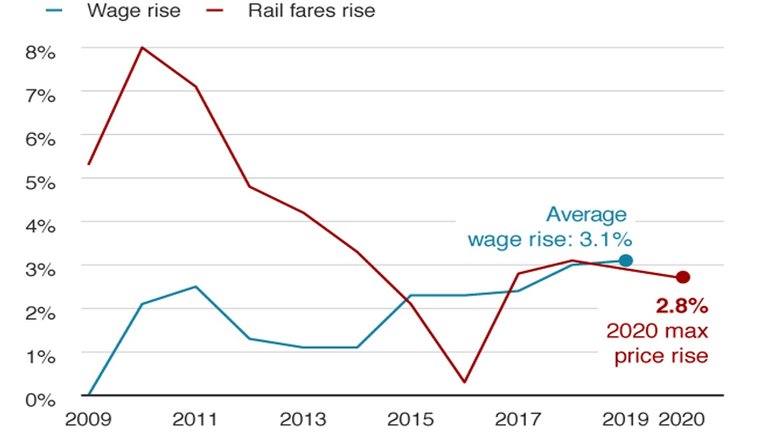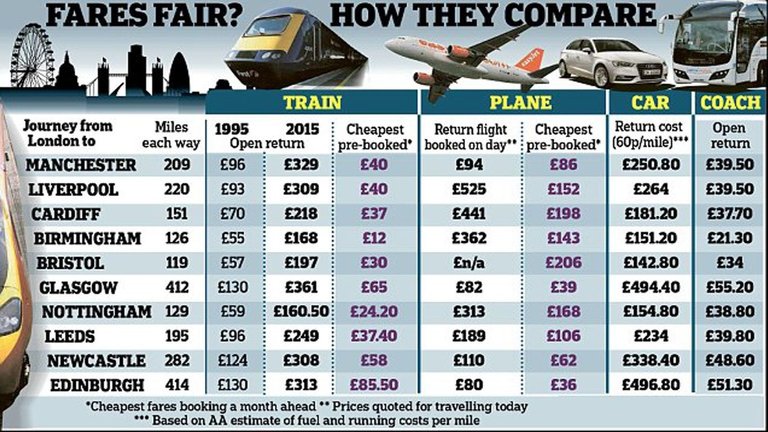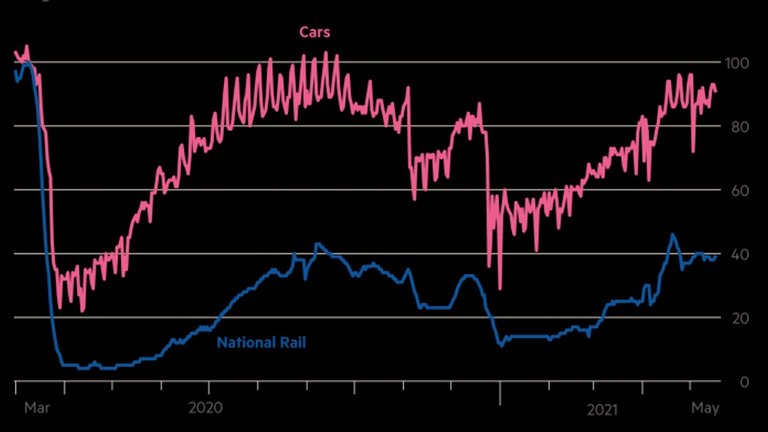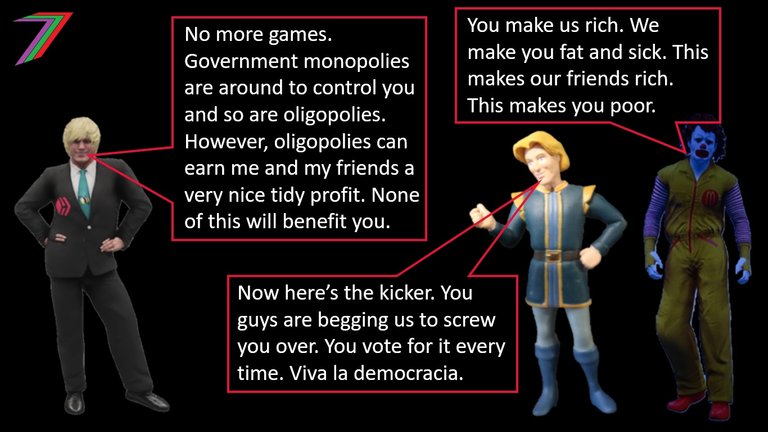Oligopoly – The market structure that does not let the market decide
Hi Everyone,

I have posted many times about market structures. I believe the types of market structures within an economy play an enormous role in how the economy functions and how well free markets operate. Below are the links to my posts describing various market types.
- Market Structure #1 - Introduction
- Market Structure #2 - Perfect Competition
- Market Structure #3 - Monopolistic Competition
- Market Structure #4 - Oligopoly
- Market Structure #5 - Monopoly
Ideally, we want market structures that facilitate both ample competition and cooperation. For this to be the case there needs to be plenty of firms in the market as well as plenty of products for people to choose. This will enable firms to compete in both and price and product specification. Product variety can enhance cooperation between firms. It is in the best interest of a firm to cooperate with firms that sell complementary goods to their own. Cooperation can exist across markets and industries if a firm’s product is an input into another firm’s product or vice versa. There are almost endless possibilities for competition and cooperation in markets with many diverse firms and products.
When there are an insufficient number of firms and products to enable both competition and cooperation, the customers and employees lose out. Below are just a few examples.
- Innovation falls.
- Customers have reduced choice.
- Responsiveness to customers’ needs fall.
- External economies are less likely to be captured.
- There is less motivation to strive for excellence.
- Workforce becomes detached from the firm’s success.
- Firms are likely to limit supply to raise prices.
- Profits are distributed in favour of owners/investors (minority) over employees (majority).
Examples of market structures that are dominated by just a few firms are oligopolies, duopolies and monopolies (just one firm).
Oligopolies vs. Monopolies

Of all the market structures, I believe oligopoly to be the worst for the economy and society in general. Many other economists might argue that monopoly is a worse market structure. On the surface that would appear to be the case. In an oligopoly market structure, there are at least several firms in a market. In a monopoly, there is only one firm. Therefore, an oligopoly should enable more competition and cooperation. Therefore, better outcomes for the market and possibly economy as a whole should be possible.
However, a monopoly market structure has one big advantage over an oligopoly market structure. The flaws of a monopoly are glaring and almost impossible to cover up. These flaws draw attention to the monopoly and lead to some form of call-to-action. Governments are typically compelled to act against the monopoly. This could involve regulation (e.g. price ceilings or offer minimal level of coverage to all communities), forced sharing of the market to facilitate competitors, or privatisation of Government monopolies. Communities and businesses may take legal action against firms that appear to have excessive monopoly power. Typically, monopolies, private in particular, struggle to survive. Most remaining monopolies are Government run and owned. They are in areas deemed to be of significant national or strategic importance such as law and order or postal services.
Privatised Government monopolies often become oligopolies. In the 1980s and 1990s, the UK privatised its energy sector and in the mid-1990s, they privatised rail. Over the past couple of decades, both sectors have experienced significant increases to prices. See Figures 1, 2, and 3
Figure 1: Energy Bills in the UK in 2010 Prices

Source: BBC
Figure 2: Wage rises vs. Rail fare rises in the UK

Source: BBC
Figure 3: Train fare comparisons across the UK and with other modes

Source: Daily Mail
Higher prices do not guarantee improved efficiency nor customer satisfaction. Figure 4 contains the public performance measure (PPM) and passenger satisfaction with train services in the UK.
Figure 4: Service performance of UK trains

Source: Network Rail
Note: PPM shows the percentage of trains which ran their entire planned journey calling at all scheduled stations and arriving at their terminating station within 5 minutes (for London & South East and regional services) or 10 minutes (for long distance services). National Rail Passenger Survey (NRPS) provides a network-wide picture of passengers’ satisfaction with rail travel.
A few large firms dominate the energy market. British Gas, EDF, E.on, npower, Scottish Power and SSE (the big six) have about a 70% share of the energy market. See Figure 5.
Figure 5: Energy Oligopoly

Source: Statista
The market structure for rail is different to energy. Firms compete over routes and geographical service area. Therefore, there are many rail operators but direct competition is limited and each route and area becomes an oligopoly or even a monopoly. See Figure 6.
Figure 6: Rail market and operators
The increasing prices and lack of improvement in efficiency and quality of products and services could be used as an argument against privatisation and even as an argument for nationalisation. However, it is not as straightforward as a simple comparison between public and private run organisations. We do not know what would of happened if these industries had continued to be run by the State. We do not know the impact regulations have played in the ability for private firms to operate. We do not know the impact Government incentives have had on private firms’ decision-making. We do not know how the management and maintenance of existing State owned infrastructure has effected the operation of the private firms. We do not how the oligopoly market structure may have influenced the private firms’ decision-making.
“Private owned vs. State owned” is the wrong debate. State owned monopolies do not perform well even if they perform moderately better, on some occasions, than private owned firms in an oligopoly market structure. Instead, we should consider the nature of the product or service being offered.
The energy sector might be considered a natural monopoly where monopoly and oligopoly market structures are the only options. The immense amount of infrastructure required to support centrally produced and stored energy prevents many firms from entering the industry. However, centrally provided energy is not the only option. People can live off-the-grid and produce energy from their homes. Solar and wind energy can be produced at home using solar panels and wind turbines respectively. Coal, wood, and oil are also options for heating in the winter and could be used to produce electricity. Energy can even be pulled directly from the atmosphere from humidity or even static electricity. If we consider these off-the-grid options, we no longer have the infrastructure barrier to entry as the market is now for the infrastructure (i.e. solar panels, wind turbines, generators, energy capturing devices, etc.) for the home rather than the service from a centralised provider. If people are unable to setup their own off-the-grid energy system, the community or neighbourhood could setup their own energy sharing distribution centres, which might be able to produce savings through bigger and/or more efficient infrastructure.
Transportation such as rail relies heavily on large physical infrastructure (i.e. train stations, tracks, bridges, signals, etc.). Therefore, monopoly or oligopoly market structures might appear to be the only way this industry could operate. This is not necessarily true. Demand for transport is a derived demand rather than direct demand for transport itself. This means people only travel because they want to be somewhere else. This has several implications. For example, rail only has demand from people who do not have an alternate less costly (includes both time and money) form of transport or comparable alternate activity that does not require train travel. Therefore, rail competes with all other modes of transport that can enable people to reach their destination. Rail competes with other locations that provide people with the same needs as the destinations accessed by rail (e.g. growth of local communities). Rail competes with activities that no longer require a physical presence (e.g. online shopping and working remotely).
During the Covid-19 lockdowns, demand for rail travel into the cities fell considerably. When lockdowns ended and the economy reopened, we should expect the demand for rail travel to return to normal or close to normal. However, this was not necessary the case. In the UK, the number of cars on the road returned to pre-lockdown levels but the number of train users did not. See Figure 7 below.
Figure 7: Demand for Cars and Rail (2020 and 2021)

Source: Financial Times
Restrictions in terms of social distancing and mask wearing may have accounted for some of reduced passenger numbers but it is unlikely to have contributed for the entire decrease. It is more likely that people found reasons for not travelling by train. People that needed to travel may have found using cars the better option if the roads had become less congested.
Neither transportation (e.g. rail) nor energy need to be either monopolies or oligopolies because they are part of large markets, which can facilitate competition from a wide variety of businesses offering a wide variety of products.
The bigger oligopoly picture

Oligopolies do not need to begin with the privatisation of a State owned monopoly. Most of the largest markets in the world closely resemble oligopoly structures. In my post, Controlled Opposition and Divide and Conquer, I describe several industries that operate within oligopoly market structures. Below is a list of markets that often fall into oligopoly market structures in many countries.
- Food
- Restaurant (Fast Food)
- Media
- Social Media
- Cruise Lines
- Hotels
- Fashion
- Internet Companies
- Cars
- Airlines
- Beer
- Sports
- Medicine
Food
Many of the large food producers and sellers focus on processed foods. Many of these processed foods contain chemicals used as preservatives. Processed meat products often contain leftover lower quality meat, which are often high in saturated fat (e.g. hot dog sausages and burgers). Even vegetables sold in supermarkets are often low quality as many of them are grown using chemical pesticides. An alternative to the big brands and supermarkets are farmers markets. These markets tend to offer a good variety of food from many different vendors. These markets foster both competition and cooperation. They compete in terms of products and price. They cooperate in terms of sharing facilities and resources as well as create a sense of community amongst themselves and their customers. Farmers markets would consist of perfect competition and monopolistic competition market structures.

Restaurant (Fast Food)
Many fast food restaurants focus on cheap and unhealthy food. Processed meats and vegetables (mostly potato) are typically fried and often sprinkled with preservatives such as salt. Fast food offers convenience and affordability. Frying saves time and mass produced processed foods are cheap. However, quickly prepared food can be healthy. Food can be served uncooked or even precooked. Food can even be fried using minimal fat; for example, using an air fried method. In Asia, in countries like Singapore, Malaysia, and Hong Kong, there are places called Hawker Centres. Hawker Centres have a wide variety of stalls selling a wide range of different foods, beverages, and deserts. Many of these stalls focus on just a few different types of food and this enables them to prepare food for customers very quickly. The prices of food are low and comparable to the large fast food restaurants. Healthiness of the food served will vary from stall to stall but people have a good choice and most stalls are independently owned.
Media (News)
Mainstream media is largely focused on providing content that will earn them the most money. This could be sensationalised stories that are deemed to attract a larger audience. This could be propaganda used to attract more sponsors and people with an allegiance to a particular political group. This rarely leads to the reporting of the most important or relevant news and rarely leads to unbiased coverage of events. There are alternative independent media outlets and even freelance or individual journalists that are motivated to reporting and covering more relevant content and are not biased or influenced by large corporate or Government demands. Their content can be found in various locations such as private websites, newsletters, online media and streaming platforms (e.g. 3Speak and BitChute). If more journalists operate independently of large mainstream media, media will longer be an oligopoly but instead a much more diverse environment with far more options for the audience. This environment would most likely foster both competition and collaboration when needed.
Social Media
Social media has the potential to enable people from all walks of life and from anywhere in the world to share information, opinions, experiences, and anything else that can be communicated through words, pictures, and videos. However, because just a few companies control social media, sharing is limited to what these companies perceive acceptable. This often aligns to what is acceptable by mainstream media. Thus, creating a monopoly on information. Decentralised blockchains can solve this problem. This is because whatever is stored on the blockchain is permanent and cannot be removed from the block it was entered on. Therefore, nothing can be 100% censored if it is stored on the blockchain. Blockchains such as Hive and Blurt have social media applications that work off their blockchains. People can decide for themselves what they consider news worthy or important. They can decide what they believe to be true or false. False information can be openly refuted and disproven, instead of manipulated if it is propaganda or simply censored if it is not.
Medicine
Large pharmaceutical companies are becoming bigger and more dominant in the medical/medicine industries. In Figure 8, see market shares for the largest pharmaceutical companies in the USA and Europe.
Figure 8: Pharmaceutical Companies Market Share (2021)

Source: Visual Capitalist
The growth and dominance of pharmaceutical companies is being significantly boosted by the Covid-19 pandemic. Companies such as Johnson & Johnson, Pfizer, AstraZeneca, BioNTech, and Moderna have developed vaccines for Covid-19. These vaccines are being distributed around the world and are mostly being funded by western Governments. The potential profits from the initial shots and reoccurring booster shots is enormous and will grow these companies’ market shares. Many of the other companies have been involved with developing new treatments for Covid-19 while others have been involved with Covid-19 testing.
The Covid-19 pandemic has not just strengthened the pharmaceutical oligopoly market structure but has turned it into a form of crony capitalism where companies no longer need to respond to consumer demand but instead focus on filling Government orders. This approach is not unique to the pandemic. Pharmaceutical companies do not need to worry about competition from the free market as Governments protect them in various ways (i.e. patents, regulations, and large Government orders for drugs). Pharmaceutical companies use their protection to pursue profits over patients’ needs. Treatments tend to be profitable as they create repeat customers who become dependent on them to manage their symptoms (Corporate Watch). Cures and preventive medicine are less popular as they do not generate more customers. The pharmaceutical business model is built around having as many sick people as possible.
If medical/medicine industries were competitive, pharmaceutical companies would be forced to change their business models. If effective cures and preventive measures became easily available, long drawn out medical treatments would no longer be wanted. Medicine should be considered a derived demand for good health. If good health can be reached without treatments, pharmaceutical companies cannot continue to grow or even maintain their size. In most cases, good health can be obtained by simply eating healthy and exercising. Other oligopolies such as food and restaurant (fast food) oligopolies are hindering healthy living thus indirectly profiting pharmaceutical companies.
Best of the rest (Quick take from a glance)
The oligopoly market structure is not a good or natural fit for sports. Teams should operate independently of each other. The best performing teams should earn more money as they build a larger following. However, leagues such as the NFL have taken over the whole industry. The product has become football entertainment over support for individual teams and their games. True sports fans support their teams and the sport because they are passionate about the on field action and the competition on display. The NFL prefers to gear their product towards mass marketing of the sport in an effort to maximise revenue. Read my post, Super Bowl – Planned Entertainment for Dollars for a more detail account.
The hotel industry has become an oligopoly because of large hotel chains. However, small businesses (local hotels, bed and breakfast, private house rentals) can compete by offering unique services and experiences, which the hotels that have become genericized by their chain cannot. Fashion has become dominated by brands that sell for a high price because they offer snob value, which they have convinced their customers is more important than quality or comfort. Locally produced fashion could offer superior quality and comfort at a lower price. Instead of buying from a boutique store, a person could buy something equivalent or better from a night market.
Cruise lines logically fit into an oligopoly structure because of the size and cost of operating cruise ships. The market would benefit from more competition but the extent of direct competition could only be limited. Competition can come in the form of alternative vacation options and travelling. Someone could visit the same destinations a cruise ship does by travelling by air or by ferry. The airlines industry has a similar problem in terms of high costs of aircraft as well as high operating costs. There are alternative forms of travel over shorter distances such as high-speed trains but there are no direct alternatives for the longest long haul flights. People could avoid travelling long distances by picking destinations closer to home and business meetings could be done remotely and/or virtually.
Conclusion

Neither monopolies nor oligopolies are good market structures for promoting competition or cooperation and neither of them normally result in good outcomes for their customers. The faults of monopolies are more often highlighted as they have an obvious absence of competition. State owned monopolies have the bad reputation of being wasteful and inefficient. Privatisation has often been promoted as the solution to the inefficiency. However, privatisation usually leads to the formation of oligopolies. These oligopolies suffer many of the same problems as the original monopolies but as these businesses are profit seeking it often results in higher prices for customers. A ‘Left’ political response to inefficiency and higher prices from private oligopolies is nationalisation. However, that will just return us to the inefficient Government monopolies. The better response is to consider competition from substitute goods and services that can operate in market structures that have minimal barriers to entries.
Governments like oligopoly market structures. It enables Governments and the private sector to work together for their own mutual benefits. However, oligopolies are not beneficial to their customers. Lack of competition leads to customers’ needs and wants not being addressed in a way most beneficial to them. For example:
- They get entertainment instead of competitive sport.
- They get treatments instead of cures.
- They get propaganda instead of news.
- They get unhealthy food instead of nutritious food.
- They get fashion names instead of quality clothing.
Competition and cooperation are essential for markets to operate efficiently and in the best interest of the customer. For that to happen, we need more small businesses competing and working together. Government intervention makes this difficult to achieve. Therefore, we need less Government intervention. We also need to create greater awareness of the alternative options that do not rely on oligopoly market structures. For example, buying food from local producers and farmers markets or becoming more self-sufficient by depending less on centrally provided amenities.
More posts

If you want to read any of my other posts, you can click on the links below. These links will lead you to posts containing my collection of works. These 'Collection of Works' posts have been updated to contain links to the Hive versions of my posts.
My CBA Udemy Course
The course contains over 10 hours of video, over 60 downloadable resources, over 40 multiple-choice questions, 2 sample case studies, 1 practice CBA, life time access and a certificate on completion. The course is priced at the Tier 1 price of £20. I believe it is frequently available at half-price.
Future of Social Media







It is nice about being lectured about this oligopoly market. I have really learnt a lot from it. Especially the fact you said it's enables both government and the private sector to work together for their mutual needs.
Government get donations and media support. Big business get to control the markets and make huge profits with minimal risk.
This post has been manually curated by @bhattg from Indiaunited community. Join us on our Discord Server.
Do you know that you can earn a passive income by delegating to @indiaunited. We share 80 % of the curation rewards with the delegators.
Here are some handy links for delegations: 100HP, 250HP, 500HP, 1000HP.
Read our latest announcement post to get more information.
Please contribute to the community by upvoting this comment and posts made by @indiaunited.
Can this generally differ from country to country? I tend to agree with this in the sense that state owned monopoly tend to reach economics of scale as a result of large patronage, hence it's a no-brainer for whatever service they offer to be cheap. This doesn't mean because its cheaper than state owned that it might actually be better.
Nigeria is run and controled my private monopolists who are paying hugely to the government to be in that positions, what do I call this? Since its in between state and private?
However I believe private monopoly to be worse especially since there are no systems put in place to actually checkmate the excessive maniplulation of price to make more profit. Private monopolists are why entrepreneur are not given patents in the Nigerian market structure.
What you describe in Nigeria sounds like crony capitalism. The Government and the private monopolies are working together to get rich at the expense of the public. In western countries it is more difficult for them to get away with that. Therefore, we have oligopolies instead. They create the impression of competition but there is very little. In many ways they are just like monopolies.
Government monopolies can provide very low price services. They could even provide free services but that does not make them efficient or good. The taxpayers are paying for all of the Governments inefficiency and even corruption through higher taxes.
Nigeria is currently a developing country and to some extent, the principles of good governance is hardly applicable in so many aspects. In an economically adept country like you pointed out, this crotone capitalism might not work out, but this is to generally suggest to you that Nigeria doesn't have the structural framework that makes the economy to function as it should. Its totally saddening.
I agree with this 100%
Posted Using LeoFinance Beta
State owned monopolies are not efficient because they don't need to be. Taxpayers money keeps flowing. Private businesses would go bankrupt if they operated the same way in a free market.
@tipu curate
https://twitter.com/spectrumecons/status/1461062779843006466
The rewards earned on this comment will go directly to the person sharing the post on Twitter as long as they are registered with @poshtoken. Sign up at https://hiveposh.com.